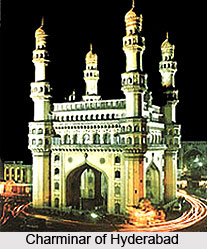Islamic art in Southern India comprises the wide variety of Islamic arts demonstrated in the South-Indian states of Andhra Pradesh, Karnataka and Kerala. The regional Islamic architectural style of the Deccan is a significant form of Islamic arts in India. Massive monumental stonework, giant domes shaped like bulbous onions which were adorned with meticulous stone carvings, stylized arches and medallions were the main characteristics of Islamic arts in these portions of the country. Besides Islamic architectural art, the art of jewellery carving constituted an important Islamic art form, especially during the Mughal Dynasty.
 Islamic Art in Andhra Pradesh
Islamic Art in Andhra Pradesh
Islamic architecture in Andhra Pradesh includes the Indo-Persian style, Qutub Shahi style and the style of Asaj Jahi. The main cities of Deccan which reflected Islamic art forms are Golconda, Bijapur, Gulbarga and Bidar. Deccani Islamic art came into prominence following the establishment of the Bahmani dynasty. The Bahmani style consisted of tombs, mosques and many other art forms which started developing in this region of Southern India. The Charminar and Charkama in Hyderabad displayed colossal arches, which was the impact of regional contribution. The Osmania University, Purani Haveli Palace, Chow Mahalla and Falaknama Palace are interesting instances of Islamic art in this state which have been influenced by Asaf Jahi. The rulers of Asaj Jahi blended the styles of European, Hindu and Islamic architecture in many of their monuments and buildings. The Tomb of Mohammad Kuri Qutub Shahi is amongst the numerous Islamic buildings which are worth mentioning.
Islamic Art in Karnataka
Gulbarga area, Karnataka is a reservoir of many Islamic art forms like the Haft Gumbaz, Bidar fort, Sora Kamba Mosque, Mehtar Mahal, etc. It is believed that a majority of these Islamic monuments have been constructed following the styles of the tomb of the Tughlaq Dynasty of Delhi. The area of Bijapur in Karnataka is famous for its vast number of Islamic ruins in the southern parts of the country. bangalore contains the palace of Tipu Sultan, which is completely based on Islamic patterns of architecture. Other Islamic buildings are tombs, mosques, palaces and forts. Geometrical motifs and detailed Islamic calligraphy have been utilized to decorate the walls, arches and pillars of these structures. The Solah Khamba Mosque, Jami Mosque and Madrasa, or school built by Mehmud Gawan are among the significant Islamic arts of Southern India. The Tomb of Al Baridi and Rangeen Mahal are enriched with wood carvings, shell work and coloured tablets. Lal Mahal, the tombs of Hyder Ali, Fakrunnisa Begum and Tipu Sultan, Ibrahim Roza and Mihrath building are amongst the several well-known Islamic arts in Southern India.
Islamic Art in Kerala
Cheraman Palli or Cheraman Juma Masjid Kanjiramottom Mosque, Thazhathangady Juma Masjid, Odathil Pally or Odathil Mosque, Pazhayangadi Mosque, Jamat Mosque and Malik Dinar Mosque are a few of the acclaimed forms of Islamic arts in the state of Kerala.
Islamic art forms in Southern India are innumerable and are quite popular among Indians and even foreign tourists.




